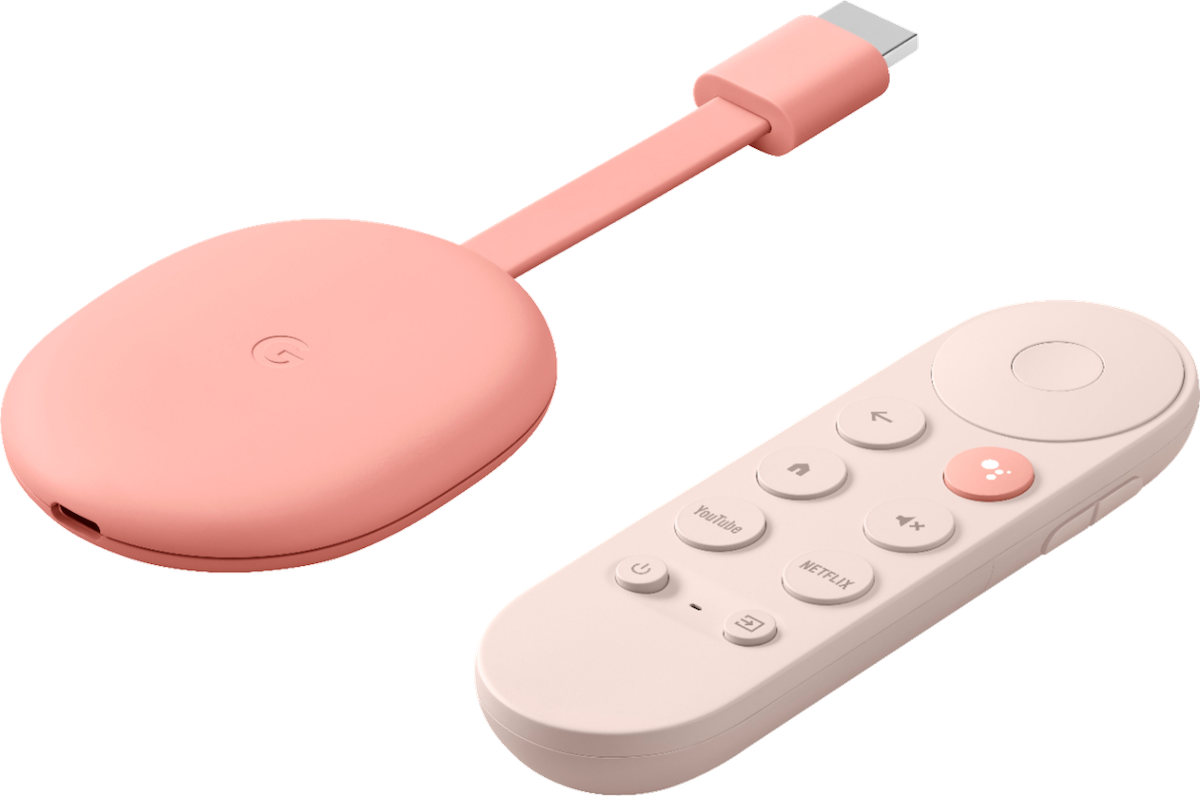Source: Joe Maring / Android Central
Tech
Chromecast with Google TV review: Google just won the living room – Android Central
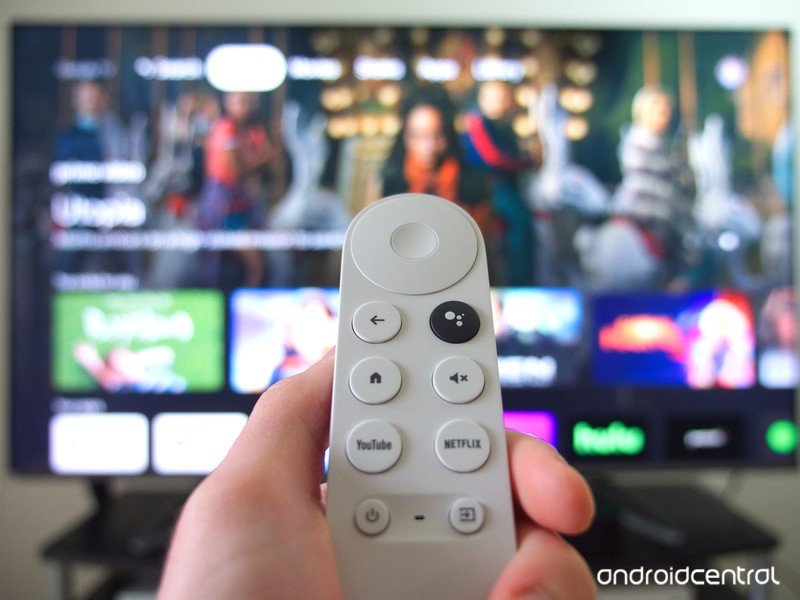
Long before the Pixel smartphones and Google’s big push for self-branded hardware, the Chromecast was a well-known entity in the streaming landscape as one of the best and most affordable ways to get video on your TV. Whether it was the $35 regular Chromecast or the more expensive Chromecast Ultra with 4K, the idea of having a cheap dongle that can play anything from your phone was a concept millions of people got behind.
As streaming media has expanded over the last few years, though, the Chromecast has started to look and feel a bit dated. Compared to the likes of Amazon’s Fire TV Sticks, the best Rokus, and the Apple TV, the lack of a remote and proper user interface have hindered the Chromecast’s functionality.
That’s now changing.
Chromecast with Google TV is the most radical update we’ve ever seen in the Chromecast series, bringing it up to feature parity with the competition while ushering in a brand new user interface. It may not be the upgrade Chromecast loyalists were hoping for, but for the rest of us, it’s basically the best Android TV box you can buy in 2020.
At a glance
Chromecast with Google TV
Bottom line: The new Chromecast with Google TV is very different from past offerings in the Chromecast family, and that’s not a bad thing. Google’s latest streaming device has everything you could ask for, ranging from 4K HDR support, Dolby Vision and Atmos, and — for the first time ever — a remote. Bundle all of that together with the excellent Google TV interface and a killer price, and the Chromecast with Google TV ends up being one of Google’s best new products in a long time.
Pros
- 4K HDR streaming
- Dolby Vision and Dolby Atmos
- Fast, responsive performance
- Google TV is great for curating content
- Excellent remote
Cons
- No fast forward/rewind buttons
- Not all streaming apps currently support Google TV integration
- Stadia doesn’t officially work yet
Chromecast with Google TV What I love

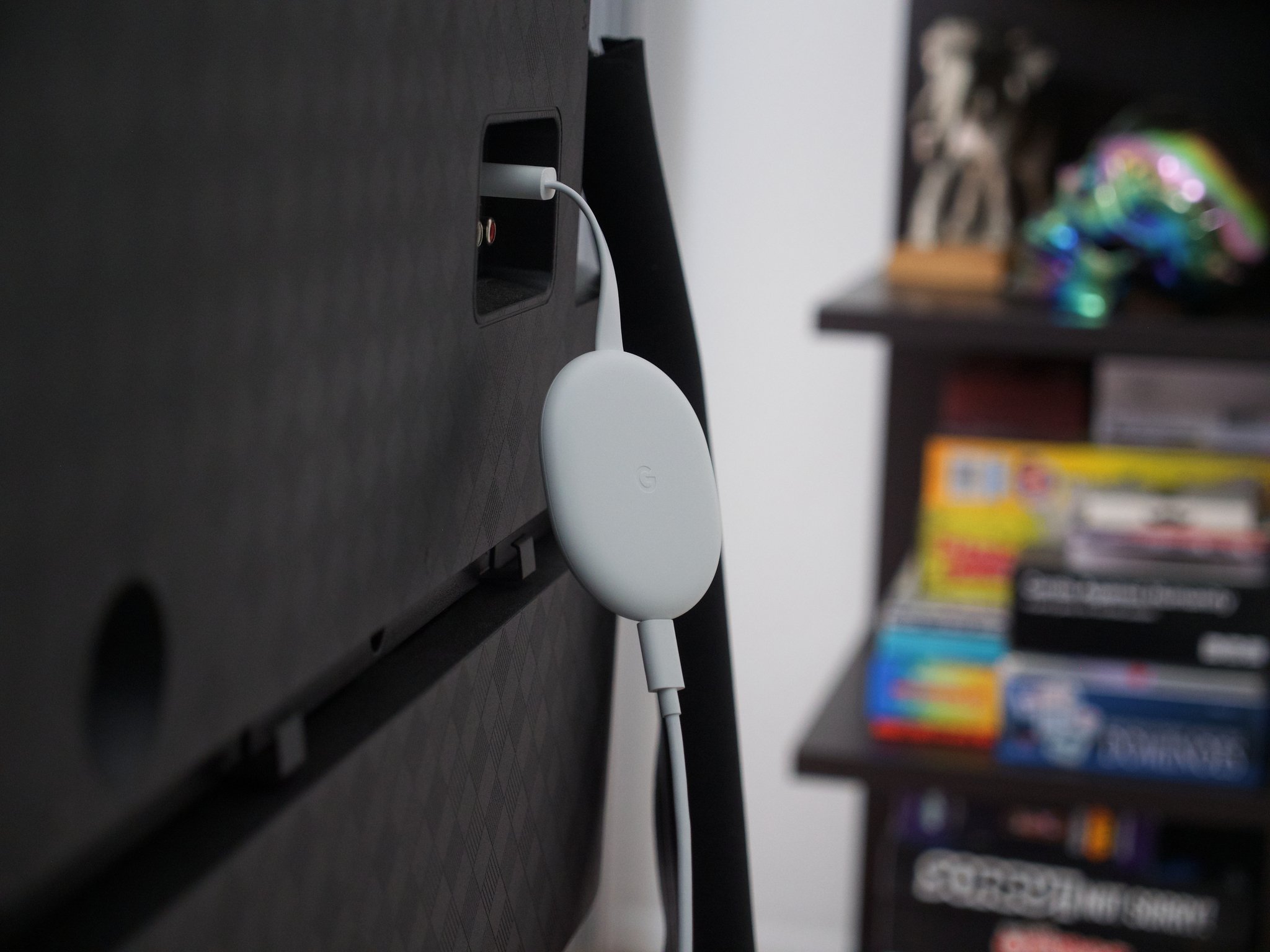 Source: Joe Maring / Android Central
Source: Joe Maring / Android Central
Let’s start with the boring stuff first — the Chromecast’s hardware. This isn’t something you’ll be actively looking at all the time, but Google did a good job of ensuring it looks nice and has all of the specs/features you could ask for in a 2020 media device.
The Chromecast itself is made out of matte plastic and connects to your TV with the attached HDMI cable. A USB-C port on the back connects to the included power cable, which then plugs into the AC adapter that powers the thing. There’s support for 4K streaming up to 60fps, HDR10 and HDR10+ are both supported, and you’ll also find Dolby Vision and Dolby Atmos.
Google offers three colors to choose from, including Snow, Sunrise, and Sky (aka white, pink, and blue). Not only does your color choice determine the color of the Chromecast itself, but it also changes how the included remote looks, as well as the included batteries. Such a small Google touch. And this is the first-ever Chromecast with an explicit visual interface and a remote.
For its grand debut, Google did a pretty good job with the remote. All of the buttons are very clicky, it is comfortable to hold (albeit a touch slippery), and you have power, input, and volume buttons for controlling those aspects of your television if its supports HDMI-CEC controls. Just like all modern Android TV boxes and televisions, you’ll also find a Google Assistant button that you can hold down to talk to the Assistant at any time.
By now, you’ve also probably noticed the YouTube and Netflix buttons. Some people might hate having branded buttons like this, but I’m personally fine with it. As someone that actively uses both services, I appreciate the quick access. You can’t officially remap the Netflix button, but if you press and hold on the YouTube one, you can switch between it opening the main YouTube app or YouTube TV. It’s a nice touch.
In all of these core regards, the Chromecast with Google TV is fantastic. It’s easy to set up, it moves through menus and apps without a hitch, video content looks excellent, and the remote doesn’t hinder any of the enjoyment you get from all of this (I’m looking at you, Apple TV).

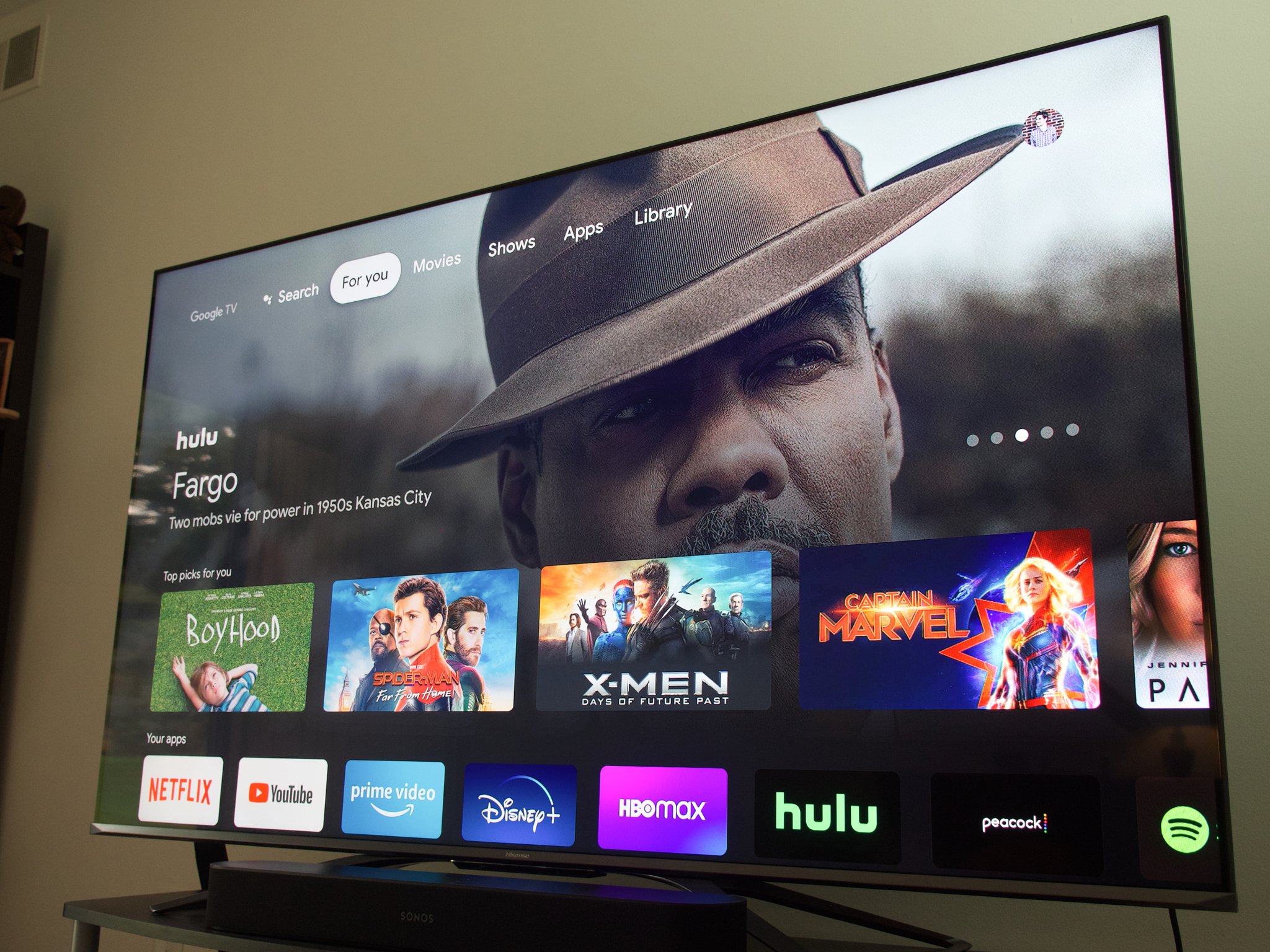 Source: Joe Maring / Android Central
Source: Joe Maring / Android Central
However, that’s just one part of this gadget. Now that we know what the Chromecast side of things brings to the table, we have to talk about the Google TV experience. Ready for a spoiler? I really, really like it.
Android TV is technically the operating system powering this new Chromecast, but the interface you interact with has been completely overhauled. The main goal of Google TV is to heavily emphasize personalized and recommended content so that it’s easier to find something to watch. There are also now dedicated pages/home screens you can navigate through, and they include the following:
- Search — Recommended commands for the Google Assistant and movie/TV show genres to browse through specific types of content.
- For you — Your main home page, showing top content picks, your installed apps, and other recommended content based on your watchlist, various genres, and more.
- Live (optional) — An integrated live channel guide that will only show up if you have YouTube TV installed and enabled.
- Movies — Browse through various movies to watch.
- Shows — Browse through various TV shows to watch.
- Apps — All of your installed apps, along with integrated Play Store access for downloading new ones.
- Library — Movies and shows you own through Google Play (now Google TV).

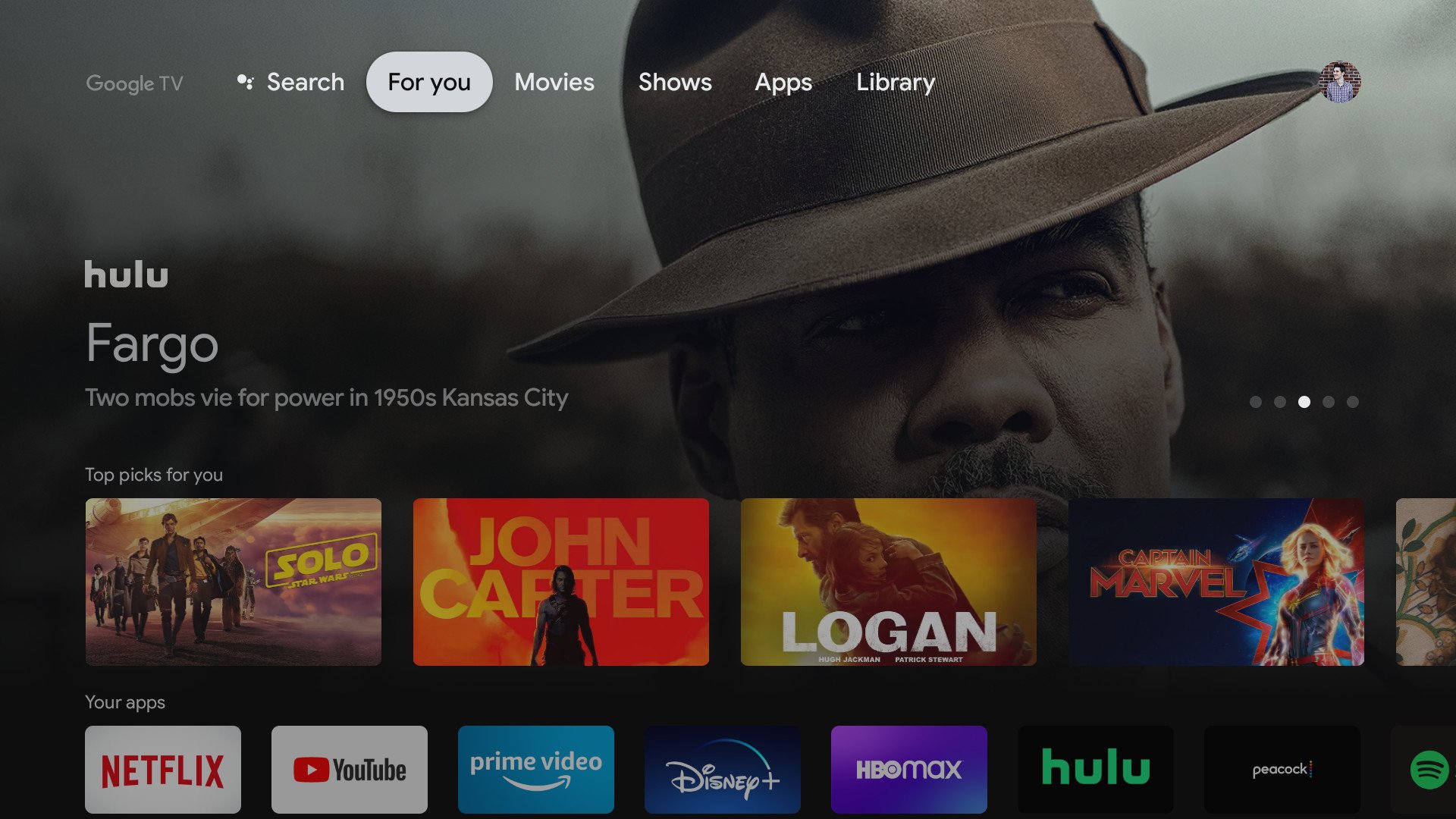

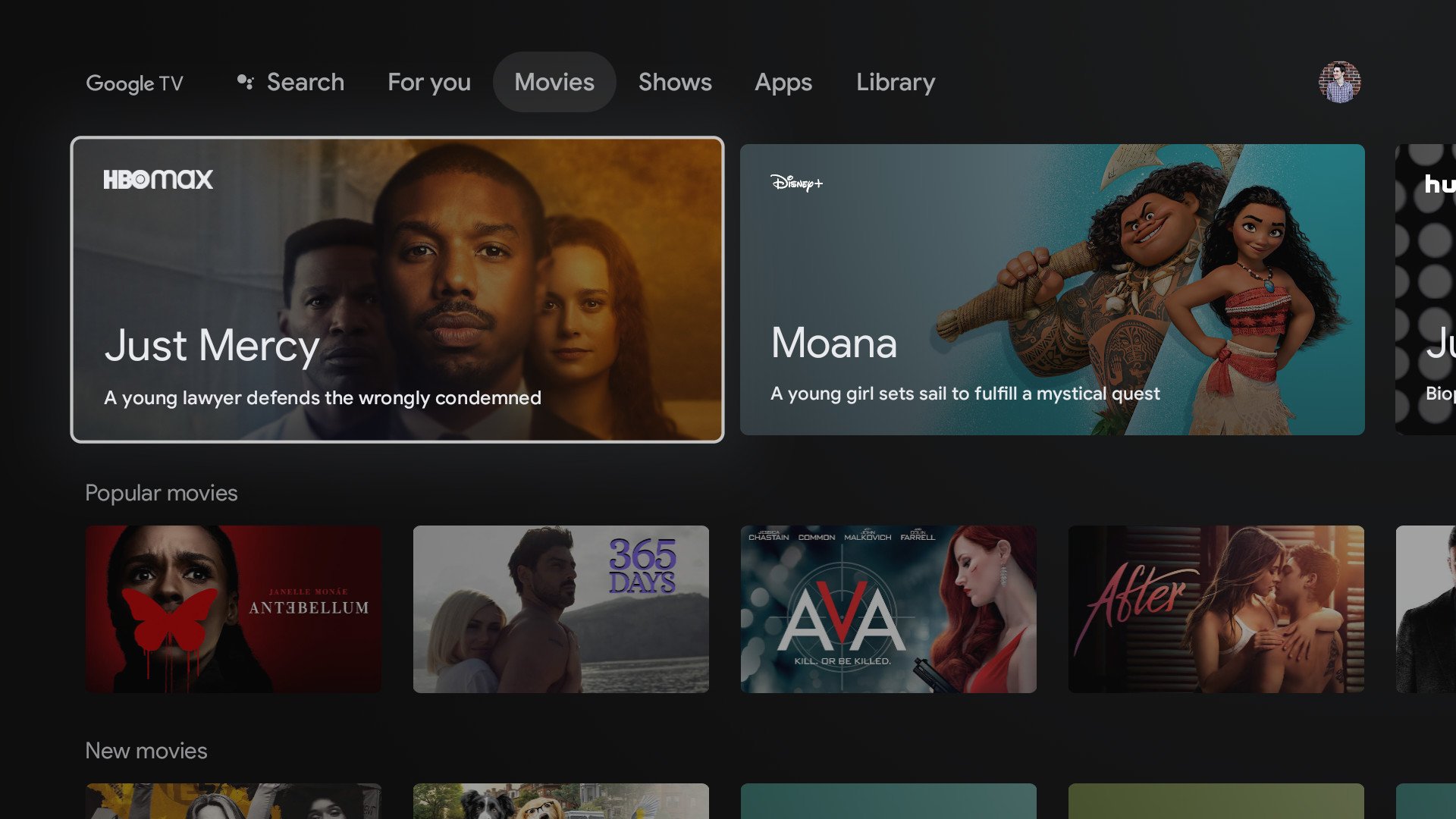 Source: Android Central
Source: Android Central

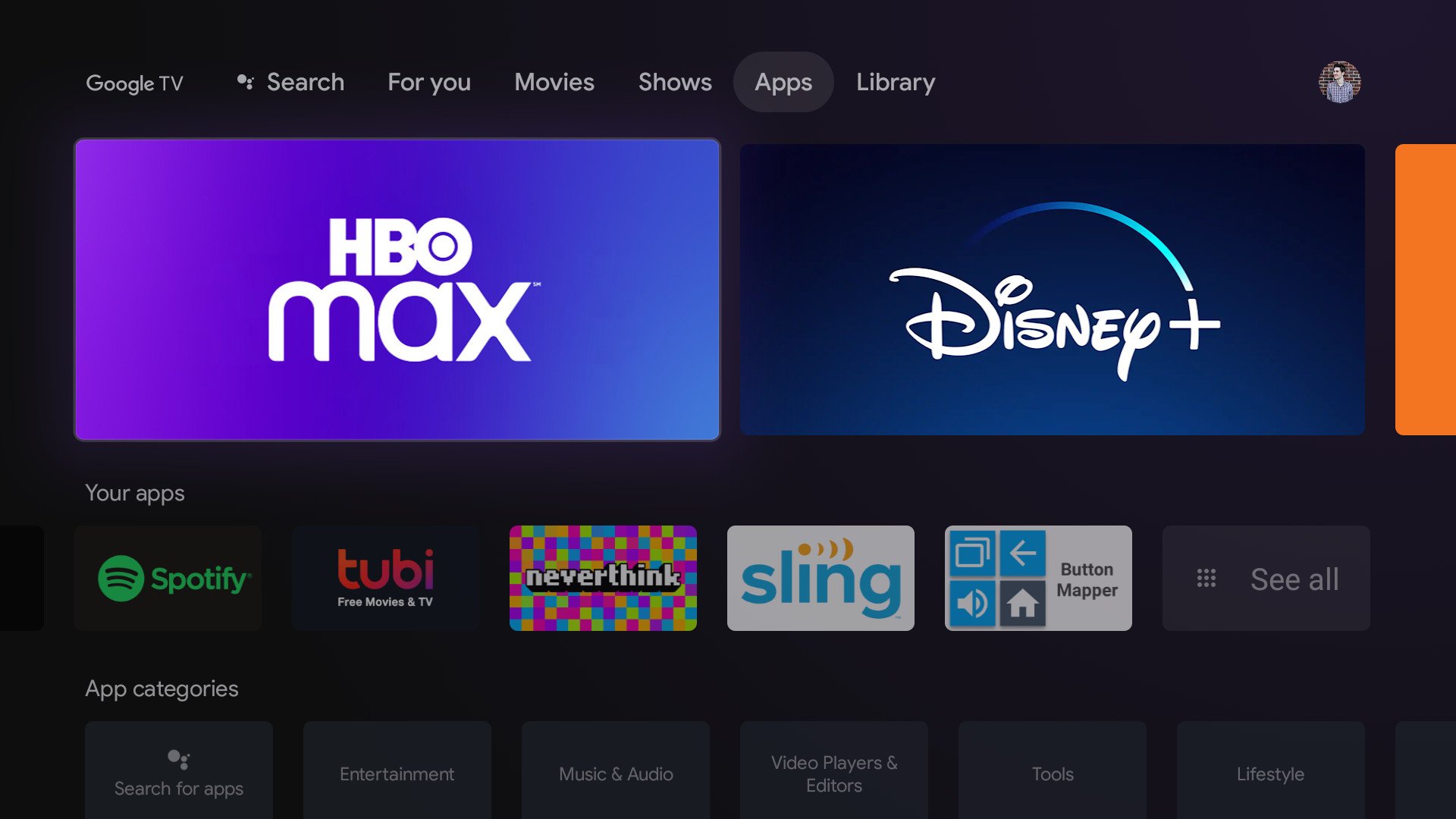

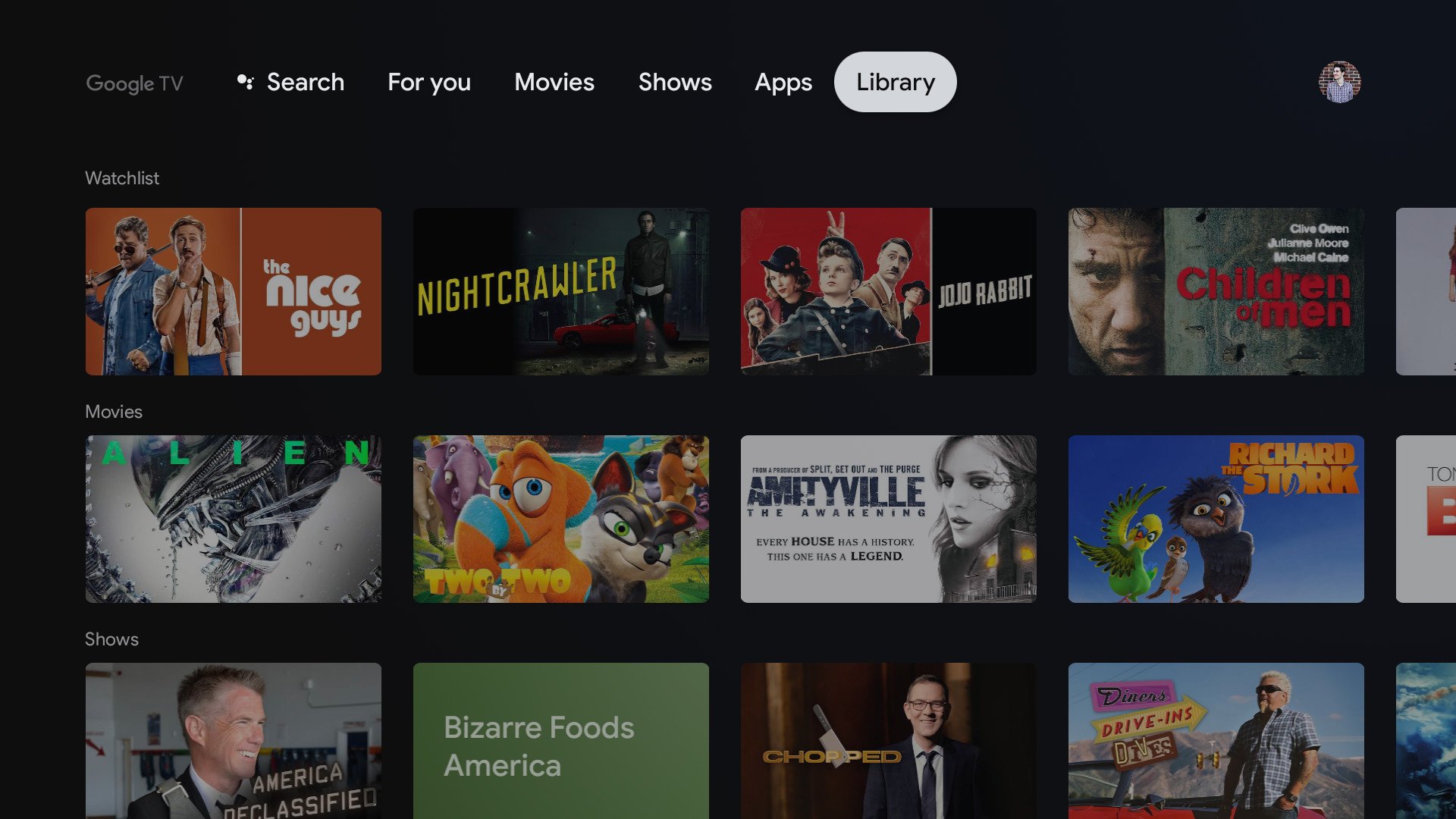 Source: Android Central
Source: Android Central
I know a lot of Android TV die-hards were bummed when they saw this new layout, but in my experience so far, it’s been a fantastic upgrade.
Right off the bat, this interface has made it substantially easier to discover shows to watch. The recommendations have been decent right off the bat, and I’m sure that’ll only get better as time goes on. Not only can you add shows/movies to your watchlist, but you can also indicate once you have actually seen it and whether or not you liked or dislike it. It can all be a little overwhelming at first with three separate pages giving you ideas of what to watch (For You, Movies, and Shows), but it’s markedly better than the half-baked app channels the regular Android TV interface has.
A quick note on Google TV vs. Android TV

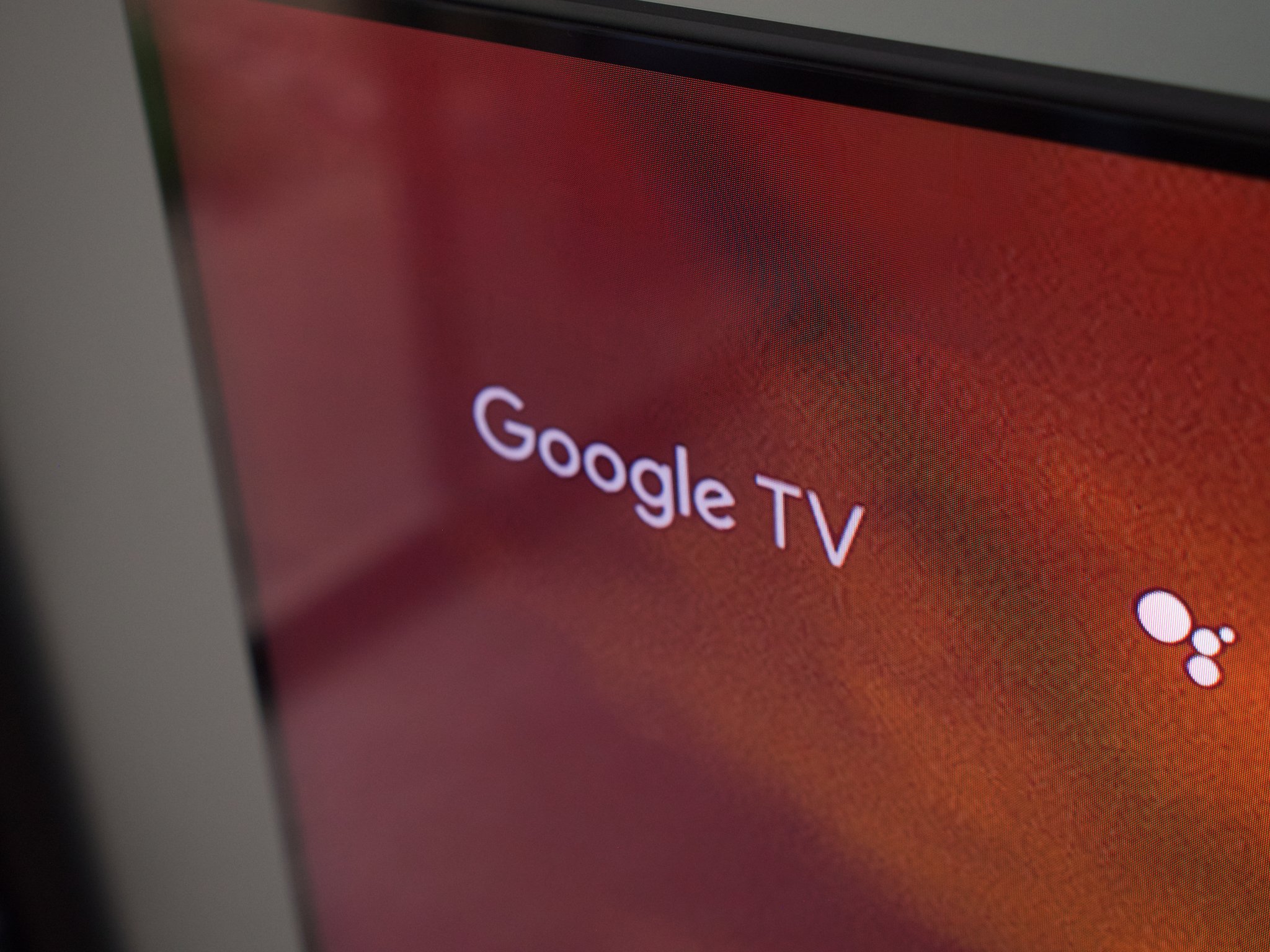 Source: Joe Maring / Android Central
Source: Joe Maring / Android Central
If you’re a little confused about what Google TV is and how it differs from Android TV, here’s a quick explainer. The core operating system of the Chromecast is still technically Android TV, based on Android 10, but Google’s added the Google TV software experience on top of it. In other words, any apps that you used on Android TV will work just as you’d expect on Google TV.
Google TV is currently exclusive to the new Chromecast, but Google says it’ll expand the interface to third-party hardware at some point in 2021. Unfortunately, we don’t know when in 2021 that’ll happen or what devices will be eligible for it.
Furthermore, Google is rebranding the current Google Play Movies & TV app to now be called Google TV. It works mostly the same, showing you content you can buy from Google directly and stuff you can watch through third-party services. The only real change here is that it’s getting a fresh coat of paint and is being marketed more heavily as a companion app to the Chromecast with Google TV.

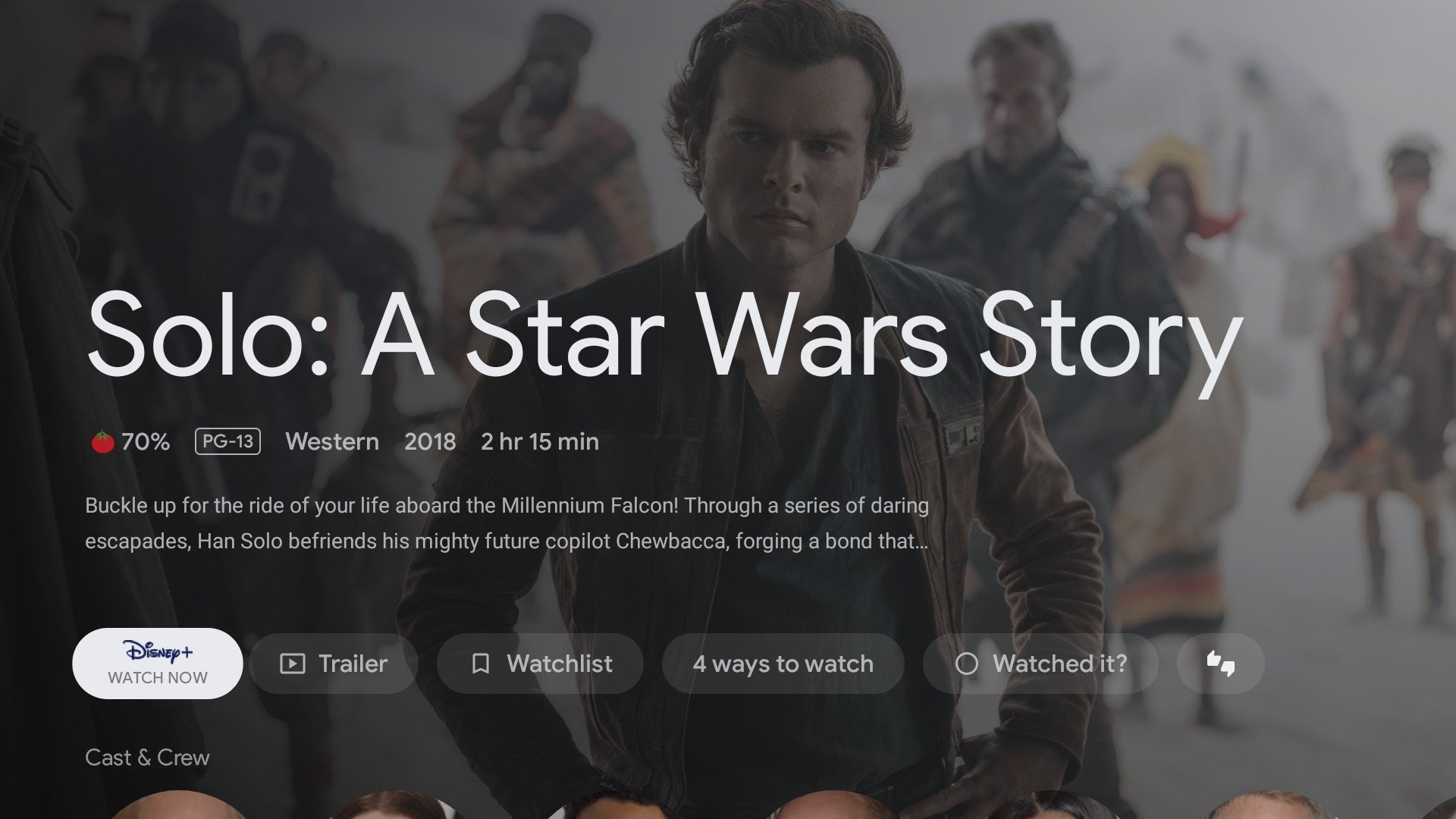 Source: Android Central
Source: Android Central
Once you do finally find something that you want to watch, clicking on the title shows you a small description, the Rotten Tomatoes score, auto-plays a trailer in the background, and surfaces the best way for you to watch it. Clicking on Solo: A Star Wars Story, for example, will make Disney+ the first way to watch it. If I select another title that’s available on Netflix, Hulu, or something else, that’ll be the service it shows on that first button.

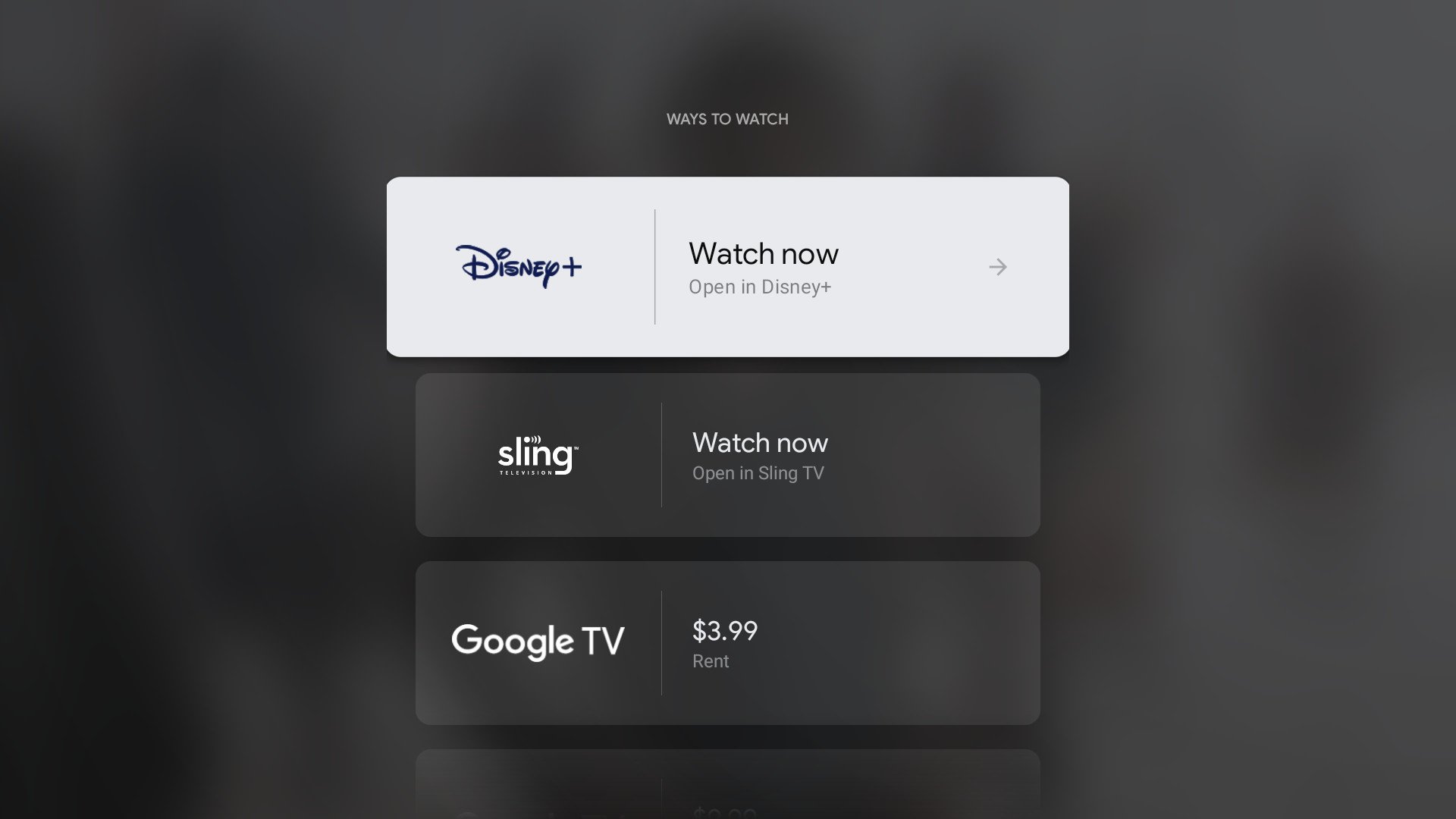

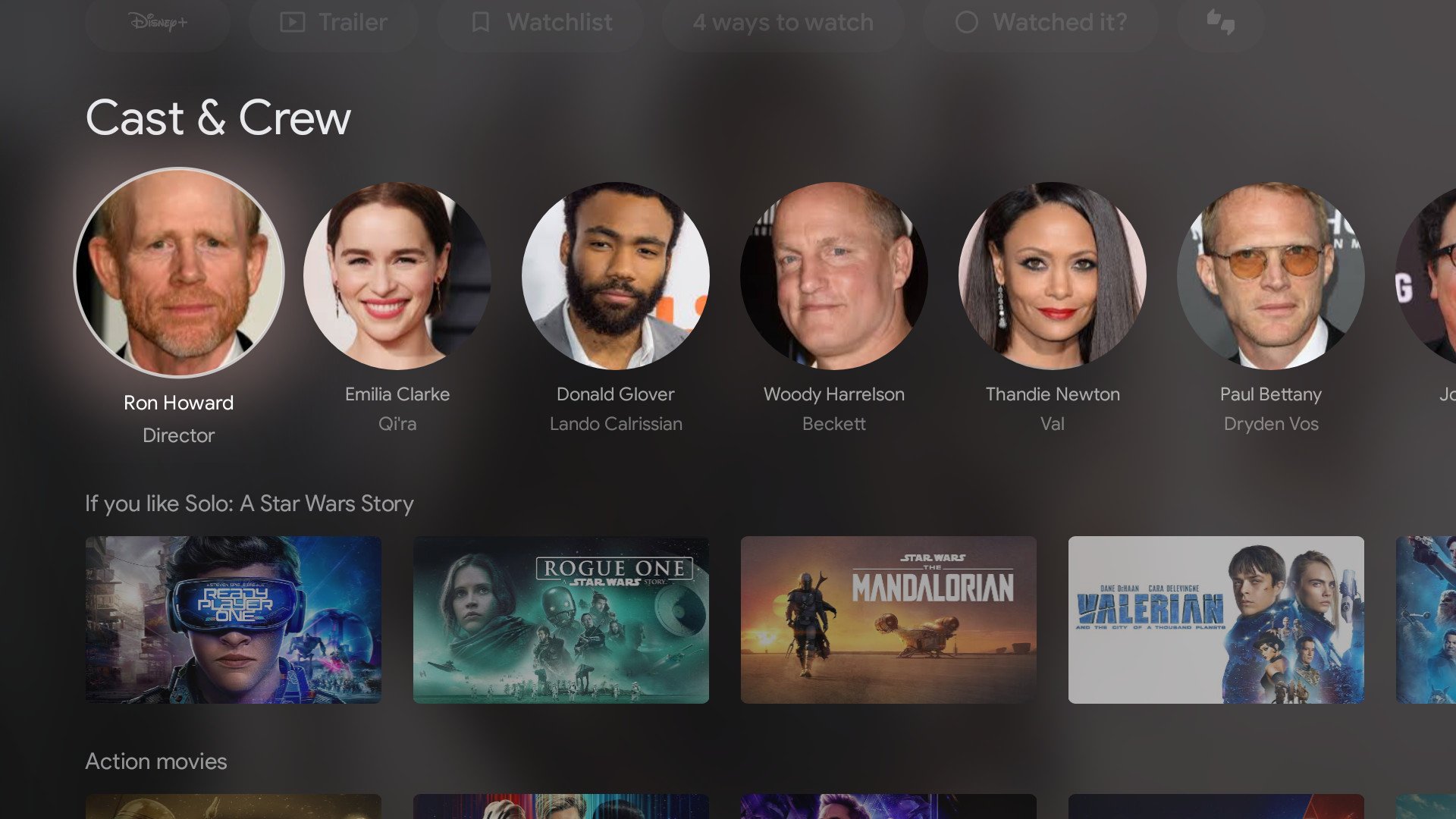 Source: Android Central
Source: Android Central
Virtually all of the recommended shows you see on the For You page (except for the Trending on Google section) come from apps/services you’ve indicated you subscribe to. If you see something that’s only available to rent or purchase, you’ll see a small lock icon next to it and its rental price. Thankfully, Google’s done a good job of integrating all of the major streaming apps into this Google TV experience. As of right now, that list includes:
- ABC
- Amazon Prime Video
- AMC
- A&E
- CBS All Access
- Crackle
- Comedy Central
- DC Universe
- Disney NOW
- Disney+
- Epix Now
- Fox Now
- Hulu
- HBO Go
- HBO Max
- History
- Lifetime
- MTV
- NBC
- Netflix
- Pluto TV
- Showtime
- Showtime Anytime
- Sling TV
- Starz
- TBS
- The CW
- TNT
- Tubi TV
- VH1
The most noticeable absence I’ve encountered so far is Peacock. While you can download and use the app just fine, none of its programming is surfaced in your recommendations. Furthermore, when using Google Assistant to search for a show like Parks and Rec, the card for the show only gives you the option to buy or rent episodes from Google Play/Google TV. This is just one example that I’m sure will be fixed in the near future, but it’s something to keep in mind if you regularly use an app that’s not on that list.
Outside of that one annoyance, however, I’ve thoroughly enjoyed everything else about Google TV. I love that it’s integrated throughout the entire interface instead of being a standalone app the way Apple handles its TV application, it’s ten times easier to find new shows to watch, and adding a show to your watchlist from Google Search also adds it to your Google TV watchlist (which is fantastic). None of these features would matter if Google had a bunch of missing gaps with supported services, so having almost all major streaming apps integrated from day one means we get to use an actual completed product rather than a work-in-progress. Coming from Google, that’s a big deal.
Chromecast with Google TV What could be improved

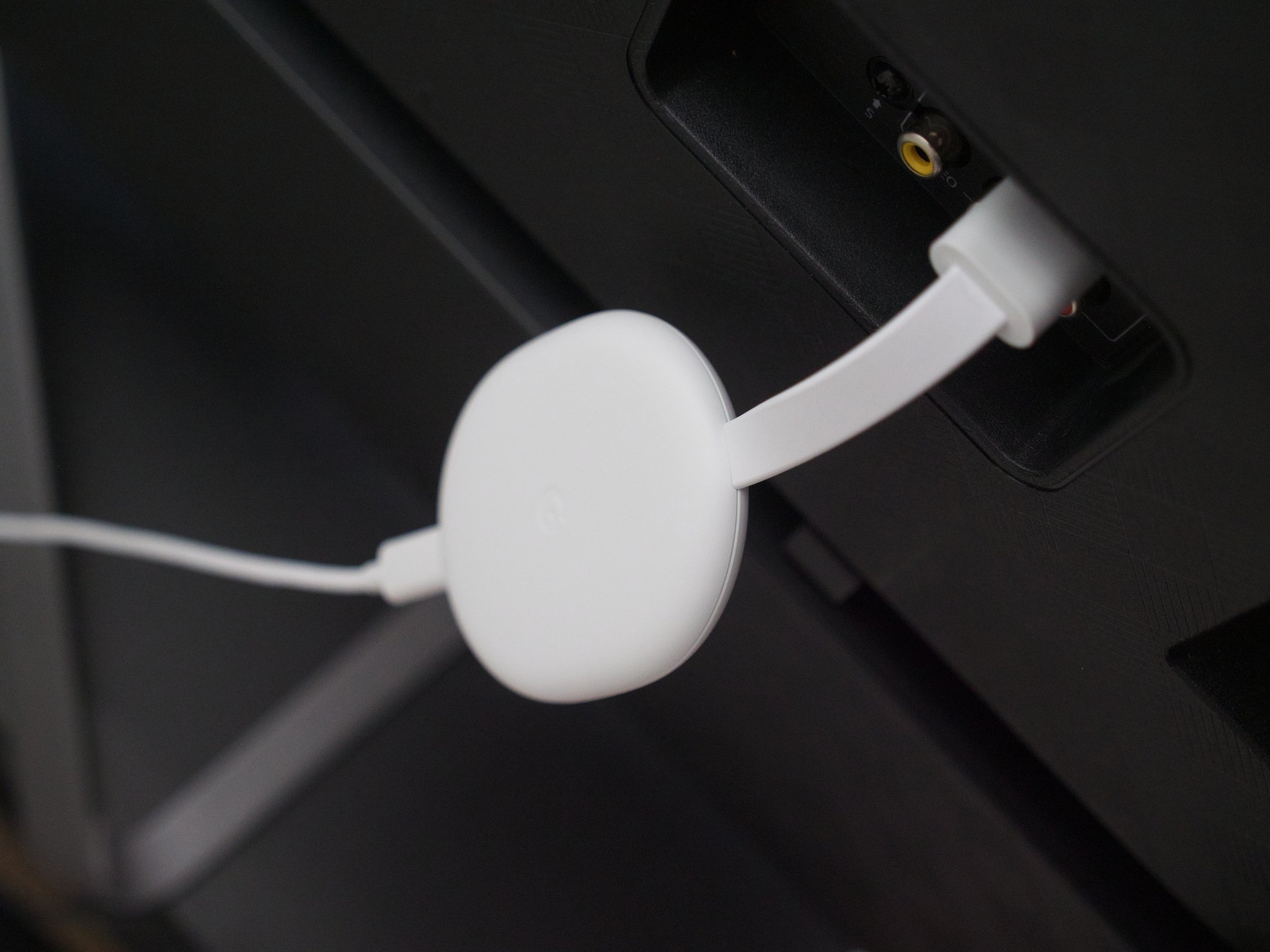 Source: Joe Maring / Android Central
Source: Joe Maring / Android Central
Google just about knocked it out of the park with the Chromecast with Google TV, but even so, there are some minor revisions I’d like to see for the Gen 2 model.
While I like the general design and feel of the remote, not having dedicated fast forward, rewind, or play/pause buttons is annoying. I’d be more than willing to have a slightly longer or wider remote if it means getting that added functionality, and I hope it’s something Google considers. It’d also be great to see things like backlit buttons and a lost remote feature, but considering the price of the Chromecast, it’s understandable why some of those things didn’t make the cut.
Finally, it’s just plain weird that Stadia isn’t supported right out of the box. It has been proven that it’s pretty easy to sideload the app and access the game streaming service that way, but it feels like a huge missed opportunity on Google’s part — especially considering how many of these things it’s likely going to sell this holiday season.
Chromecast with Google TV The competition

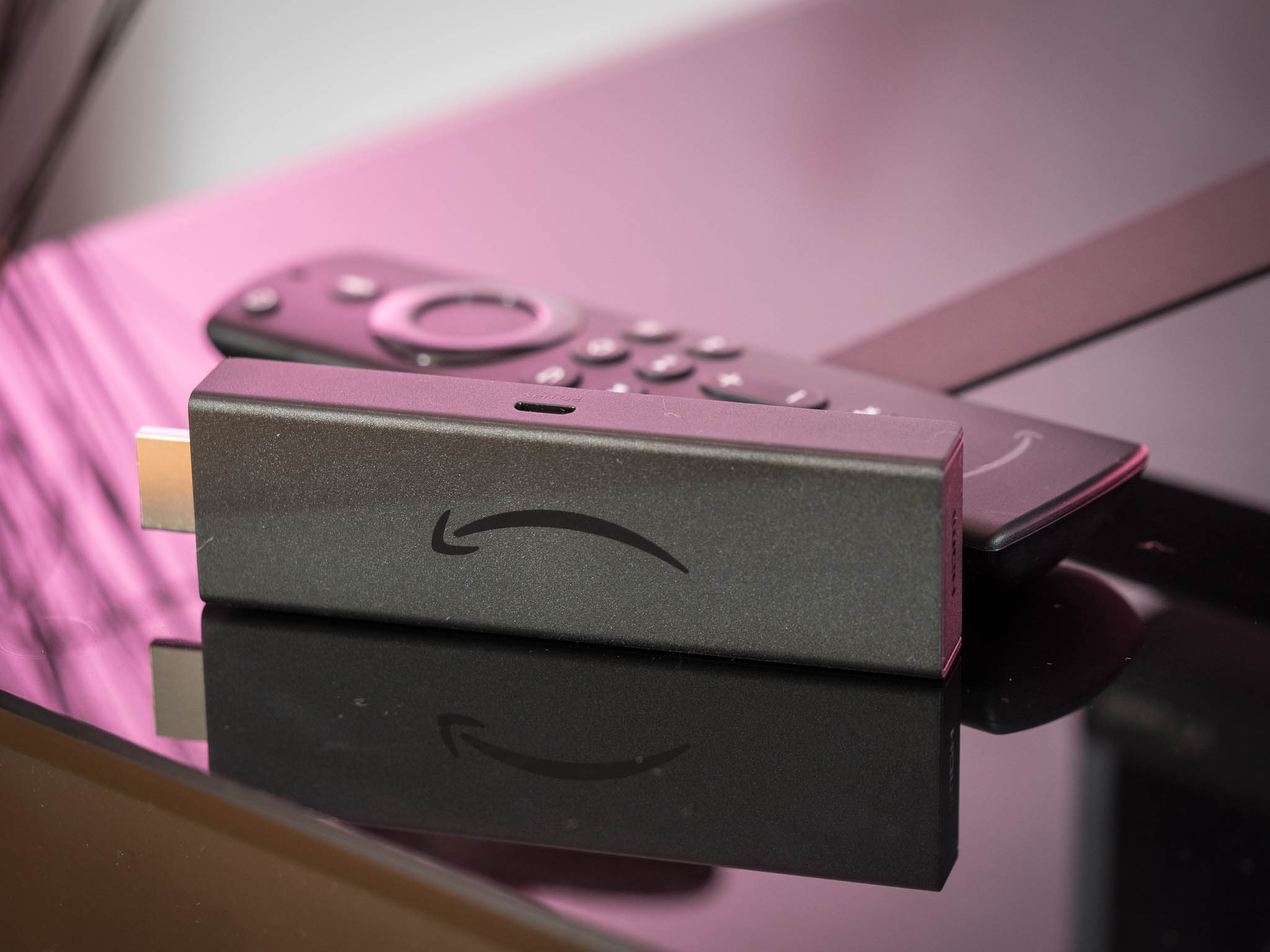 Source: Android Central
Source: Android Central
The Chromecast with Google TV is an absolute joy to use, but before you make any purchasing decision, keep in mind that it’s faced with a heap of fierce competition.
One of the most direct competitors is the Amazon Fire TV Stick 4K, which delivers 4K HDR streaming with Dolby Vision/Atmos for the same $50 price. You also get an Alexa voice remote with volume controls for your television, and there’s the same 8GB of storage for all of your apps. The main difference between the two is the software they run, with the Fire TV Stick putting a greater emphasis on Prime Video content above all else. It also supports Amazon’s Luna for game streaming, whereas the Chromecast will get Stadia support down the road.
Another option to consider is the TiVo Stream 4K. Similar to the Chromecast, it’s an Android TV-powered device with 4K, HDR, Dolby Vision, and Dolby Atmos. It’s running the regular version of Android TV, but it comes with the exclusive TiVo Stream app that’s similar to Google TV in its ability to show personalized content from services you subscribe to. And, you guessed it, it only costs $49.
Finally, we have to mention the NVIDIA Shield TV 4K. This was previously the go-to Android TV recommendation before the new Chromecast came out, and there are still some things it does better than Google. Its remote is more functional, there’s a microSD card slot for easily expanding your storage, and NVIDIA’s 4K AI upscaling feature is surprisingly awesome. Its software interface is still the old Android TV, and while it’s possible it’ll get upgraded to Google TV in 2021, nothing has been confirmed quite yet. There’s also the higher price tag to consider, with the $150 asking price likely being too much for some shoppers.
Chromecast with Google TV Should you buy it?

 Source: Joe Maring / Android Central
Source: Joe Maring / Android Central
You should buy this if …
You want to stream content in 4K, HDR, and Dolby Vision
All of the three key components to high-quality streaming are present on the Chromecast with Google TV. It supports 4K at 60fps, HDR10 and HDR10+ are present, and there’s Dolby Vision for shows that take advantage of the format. It also supports Dolby Atmos for dynamic audio with supported setups.
You want to simplify the way you use streaming apps
Most streaming devices have good user interfaces, but the new Google TV layout manages to stand out as something special. From curating all of your content into one place and personalizing recommendations the more you use it, it’s something that’s greatly appreciated in a world where new streaming apps are launching all the time.
You don’t want to spend a lot of money
At just $50, the Chromecast with Google TV is an easy recommendation for just about any budget. Plus, at the rate Google frequently discounts its products, it shouldn’t be uncommon to find it on sale for even less.
You should not buy this if …
You want 4K upscaling
NVIDIA’s 4K upscaling feature on the Shield TV really impressed us, making HD content look just as good as native 4K stuff. Unfortunately, that’s not a feature you’ll find on the Chromecast with Google TV.
You need more than 8GB of storage
Google gives you 8GB of built-in storage for apps/games, and while that should be enough for most folks, power-users may need more room. With no microSD card support, you won’t be expanding storage on the new Chromecast any time soon.
You watch a lot of Apple TV+
The app selection for Android TV has gotten much better in recent years, but there are still some gaps here and there. Right now, the most notable absence is the Apple TV app. If you watch a lot of shows from Apple TV+, you’ll want to consider getting something else.
As interested as I am in other Google products like the Pixel 5 and Nest Audio, I found myself most looking forward to the Chromecast with Google TV leading up to its announcement. I’ve always felt kind of bad for Android TV. It’s a solid platform with lots of potential, but Google just never seemed to care much about it. It’s been a long wait for a first-party streaming device from the company, but it was well, well worth it.
The Chromecast with Google TV isn’t as fully-featured or spec-heavy as something like an NVIDIA Shield TV, but as a device that’s designed to stream video content and help you find stuff to watch, it’s amazing. As confusing as the branding around it may be, Google TV is an exceptional leap forward for Google’s presence in the living room. Especially in a world where it’s becoming increasingly difficult to keep up with new streaming services and licensing deals, Google TV does something legitimately helpful to address that confusion.
We’ll see how this Chromecast holds up as other hardware starts getting the Google TV interface for themselves in the coming months, but even then, it’ll still stand out as an affordable $50 streamer with 4K, a great remote, and fast performance. Google did just about everything right with this one, and if you ask me, Roku and Amazon should be paying close attention.
Living room champ
Chromecast with Google TV
The Chromecast with Google TV marks the beginning of a new vision for Google’s presence in the living room, and in just about every regard, it paid off. The new Google TV interface is a massive upgrade, making it easier than ever to find what you want to watch and knowing where you can watch it. Not only was that risk worth it, but Google stuck the landing with capable hardware and a phenomenal price.
We may earn a commission for purchases using our links. Learn more.
Tech
Ottawa orders TikTok’s Canadian arm to be dissolved

The federal government is ordering the dissolution of TikTok’s Canadian business after a national security review of the Chinese company behind the social media platform, but stopped short of ordering people to stay off the app.
Industry Minister François-Philippe Champagne announced the government’s “wind up” demand Wednesday, saying it is meant to address “risks” related to ByteDance Ltd.’s establishment of TikTok Technology Canada Inc.
“The decision was based on the information and evidence collected over the course of the review and on the advice of Canada’s security and intelligence community and other government partners,” he said in a statement.
The announcement added that the government is not blocking Canadians’ access to the TikTok application or their ability to create content.
However, it urged people to “adopt good cybersecurity practices and assess the possible risks of using social media platforms and applications, including how their information is likely to be protected, managed, used and shared by foreign actors, as well as to be aware of which country’s laws apply.”
Champagne’s office did not immediately respond to a request for comment seeking details about what evidence led to the government’s dissolution demand, how long ByteDance has to comply and why the app is not being banned.
A TikTok spokesperson said in a statement that the shutdown of its Canadian offices will mean the loss of hundreds of well-paying local jobs.
“We will challenge this order in court,” the spokesperson said.
“The TikTok platform will remain available for creators to find an audience, explore new interests and for businesses to thrive.”
The federal Liberals ordered a national security review of TikTok in September 2023, but it was not public knowledge until The Canadian Press reported in March that it was investigating the company.
At the time, it said the review was based on the expansion of a business, which it said constituted the establishment of a new Canadian entity. It declined to provide any further details about what expansion it was reviewing.
A government database showed a notification of new business from TikTok in June 2023. It said Network Sense Ventures Ltd. in Toronto and Vancouver would engage in “marketing, advertising, and content/creator development activities in relation to the use of the TikTok app in Canada.”
Even before the review, ByteDance and TikTok were lightning rod for privacy and safety concerns because Chinese national security laws compel organizations in the country to assist with intelligence gathering.
Such concerns led the U.S. House of Representatives to pass a bill in March designed to ban TikTok unless its China-based owner sells its stake in the business.
Champagne’s office has maintained Canada’s review was not related to the U.S. bill, which has yet to pass.
Canada’s review was carried out through the Investment Canada Act, which allows the government to investigate any foreign investment with potential to might harm national security.
While cabinet can make investors sell parts of the business or shares, Champagne has said the act doesn’t allow him to disclose details of the review.
Wednesday’s dissolution order was made in accordance with the act.
The federal government banned TikTok from its mobile devices in February 2023 following the launch of an investigation into the company by federal and provincial privacy commissioners.
— With files from Anja Karadeglija in Ottawa
This report by The Canadian Press was first published Nov. 6, 2024.
The Canadian Press. All rights reserved.
Health
Here is how to prepare your online accounts for when you die

LONDON (AP) — Most people have accumulated a pile of data — selfies, emails, videos and more — on their social media and digital accounts over their lifetimes. What happens to it when we die?
It’s wise to draft a will spelling out who inherits your physical assets after you’re gone, but don’t forget to take care of your digital estate too. Friends and family might treasure files and posts you’ve left behind, but they could get lost in digital purgatory after you pass away unless you take some simple steps.
Here’s how you can prepare your digital life for your survivors:
Apple
The iPhone maker lets you nominate a “ legacy contact ” who can access your Apple account’s data after you die. The company says it’s a secure way to give trusted people access to photos, files and messages. To set it up you’ll need an Apple device with a fairly recent operating system — iPhones and iPads need iOS or iPadOS 15.2 and MacBooks needs macOS Monterey 12.1.
For iPhones, go to settings, tap Sign-in & Security and then Legacy Contact. You can name one or more people, and they don’t need an Apple ID or device.
You’ll have to share an access key with your contact. It can be a digital version sent electronically, or you can print a copy or save it as a screenshot or PDF.
Take note that there are some types of files you won’t be able to pass on — including digital rights-protected music, movies and passwords stored in Apple’s password manager. Legacy contacts can only access a deceased user’s account for three years before Apple deletes the account.
Google takes a different approach with its Inactive Account Manager, which allows you to share your data with someone if it notices that you’ve stopped using your account.
When setting it up, you need to decide how long Google should wait — from three to 18 months — before considering your account inactive. Once that time is up, Google can notify up to 10 people.
You can write a message informing them you’ve stopped using the account, and, optionally, include a link to download your data. You can choose what types of data they can access — including emails, photos, calendar entries and YouTube videos.
There’s also an option to automatically delete your account after three months of inactivity, so your contacts will have to download any data before that deadline.
Facebook and Instagram
Some social media platforms can preserve accounts for people who have died so that friends and family can honor their memories.
When users of Facebook or Instagram die, parent company Meta says it can memorialize the account if it gets a “valid request” from a friend or family member. Requests can be submitted through an online form.
The social media company strongly recommends Facebook users add a legacy contact to look after their memorial accounts. Legacy contacts can do things like respond to new friend requests and update pinned posts, but they can’t read private messages or remove or alter previous posts. You can only choose one person, who also has to have a Facebook account.
You can also ask Facebook or Instagram to delete a deceased user’s account if you’re a close family member or an executor. You’ll need to send in documents like a death certificate.
TikTok
The video-sharing platform says that if a user has died, people can submit a request to memorialize the account through the settings menu. Go to the Report a Problem section, then Account and profile, then Manage account, where you can report a deceased user.
Once an account has been memorialized, it will be labeled “Remembering.” No one will be able to log into the account, which prevents anyone from editing the profile or using the account to post new content or send messages.
X
It’s not possible to nominate a legacy contact on Elon Musk’s social media site. But family members or an authorized person can submit a request to deactivate a deceased user’s account.
Passwords
Besides the major online services, you’ll probably have dozens if not hundreds of other digital accounts that your survivors might need to access. You could just write all your login credentials down in a notebook and put it somewhere safe. But making a physical copy presents its own vulnerabilities. What if you lose track of it? What if someone finds it?
Instead, consider a password manager that has an emergency access feature. Password managers are digital vaults that you can use to store all your credentials. Some, like Keeper,Bitwarden and NordPass, allow users to nominate one or more trusted contacts who can access their keys in case of an emergency such as a death.
But there are a few catches: Those contacts also need to use the same password manager and you might have to pay for the service.
___
Is there a tech challenge you need help figuring out? Write to us at onetechtip@ap.org with your questions.
Tech
Google’s partnership with AI startup Anthropic faces a UK competition investigation

LONDON (AP) — Britain’s competition watchdog said Thursday it’s opening a formal investigation into Google’s partnership with artificial intelligence startup Anthropic.
The Competition and Markets Authority said it has “sufficient information” to launch an initial probe after it sought input earlier this year on whether the deal would stifle competition.
The CMA has until Dec. 19 to decide whether to approve the deal or escalate its investigation.
“Google is committed to building the most open and innovative AI ecosystem in the world,” the company said. “Anthropic is free to use multiple cloud providers and does, and we don’t demand exclusive tech rights.”
San Francisco-based Anthropic was founded in 2021 by siblings Dario and Daniela Amodei, who previously worked at ChatGPT maker OpenAI. The company has focused on increasing the safety and reliability of AI models. Google reportedly agreed last year to make a multibillion-dollar investment in Anthropic, which has a popular chatbot named Claude.
Anthropic said it’s cooperating with the regulator and will provide “the complete picture about Google’s investment and our commercial collaboration.”
“We are an independent company and none of our strategic partnerships or investor relationships diminish the independence of our corporate governance or our freedom to partner with others,” it said in a statement.
The U.K. regulator has been scrutinizing a raft of AI deals as investment money floods into the industry to capitalize on the artificial intelligence boom. Last month it cleared Anthropic’s $4 billion deal with Amazon and it has also signed off on Microsoft’s deals with two other AI startups, Inflection and Mistral.
The Canadian Press. All rights reserved.
-

 News16 hours ago
News16 hours agoChrystia Freeland says carbon rebate for small businesses will be tax-free
-

 News16 hours ago
News16 hours agoFACT FOCUS: Election officials knock down Starlink vote rigging conspiracy theories
-

 News16 hours ago
News16 hours agoNova Scotia election promise tracker: What has been promised by three main parties?
-

 News16 hours ago
News16 hours agoFormer B.C. premier John Horgan, who connected with people, dies at 65
-

 News16 hours ago
News16 hours agoSuncor Energy earnings rise to $2.02 billion in third quarter
-

 News16 hours ago
News16 hours agoSwearing-in ceremonies at B.C. legislature mark start of new political season
-

 News16 hours ago
News16 hours agoNew Brunswick premier confirms her Liberal government will draft carbon pricing plan
-

 News16 hours ago
News16 hours agoB.C. teen with bird flu is in critical care, infection source unknown: health officer

